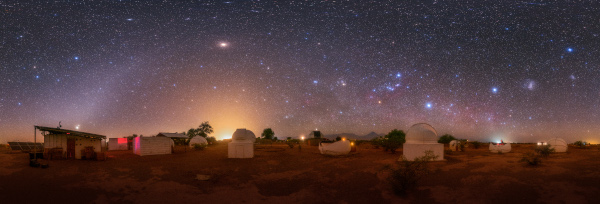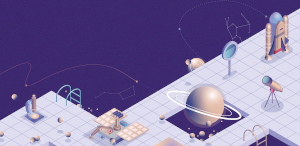This page describes an image Chilean observatories at home office, by Robert Barsa, Slovakia
Image caption:
Third place in the 2021 IAU OAE Astrophotography Contest, category Wide star fields.
This rich panoramic image shows a range of constellations, deep sky objects and planets. The brightest point of light with a pale reddish hue (left of center) is the planet Mars. In the bottom far left of the image, located just above the sloped roof of the building are two points of light appearing very close to each other, these are the planets Jupiter (brighter) and Saturn. To the far right of the image the two fuzzy cloud-like objects are the Large and Small Magellanic Clouds. These are satellite dwarf galaxies of the Milky Way located at a distance of approximately 160,000 and 200,000 light years, respectively. The Andromeda Galaxy, which is located at an approximate distance of 2.5 million light years, appears in this image as a small, angled smudge between Mars and the brightest glow on the horizon (closer to the horizon). The bright glow is not from the Sun or the Moon, but the city lights of San Pedro de Atacama.
Prominent constellations include: Orion – identified by the three stars forming Orion’s Belt; Taurus – a small triangle shaped collection of stars to the left of Orion and identified by the pale orange star (Aldebaran) at the vertex of the triangle; Canis Major – to the bottom right of Orion, identified by the bright star Sirius (the brightest star in the night sky) and three stars in the shape of a triangle just above the observatory dome in the foreground; Pegasus – identified by the trapezium shape diagonally below Mars. Other constellations include Andromeda, Perseus and Aries. Diverse cultures around the world have their own names and rich stories associated with these constellations and many others.
To the top right of Orion’s Belt is an angled line of stars (Orion’s Sword) within which is a pinkish smudge (looks like a fuzzy star when observed with the unaided eye) that is the Orion Nebula – a stellar nursery located 1500 light years from Earth – where stars are formed. To the left of Taurus is a compact fuzzy smudge, and that is the Pleiades star cluster. The variation in the colour of stars is the result of temperature of the stars, for example, the red orange star to the bottom left of Orion’s Belt is the red giant star Betelgeuse. Cooler stars appear redder, compared to the higher temperature white and bluish stars. The colours in the image are enhanced because of the higher sensitivity of the digital camera compared to the human eye.
Scroll to captions in other languages
Image credit:
Robert Barsa/IAU OAE
DOI: 10.5281/zenodo.5426192
Related glossary terms:
Aries
, Astronomy
, Observatory
Categories:
Naked Eye Astronomy
, Telescopes, Instruments and Observatories
Image license: Creative Commons Attribution 4.0 International (CC BY 4.0) Creative Commons Attribution 4.0 International (CC BY 4.0) icons
The media file captions presented on the OAE website were written, translated and reviewed by a collective effort from the OAE, the OAE Centers and Nodes, the OAE National Astronomy Education Coordinators (NAECs) and other volunteers. You can find a full list of credits for our translation project here. All media file captions are released under a Creative Commons CC BY-4.0 license and should be credited to "IAU OAE". The media files themselves may have different licenses (see above) and should be credited as listed above under "credit".
If you notice a factual error in this caption or an error in any of its translations then please get in touch.
Captions in Different Languages:
Image caption: ২০২১ আইএইউ ওএঈ অ্যাস্ট্রোফটোগ্রাফি প্রতিযোগিতায় তৃতীয় স্থান, ক্যাটাগরি ওয়াইড স্টার ফিল্ড।
এই সমৃদ্ধ প্যানোরামিক চিত্রটি নক্ষত্রপুঞ্জ, গভীর আকাশের বস্তু এবং গ্রহগুলির একটি পরিসর দেখায়। একটি ফ্যাকাশে লাল বর্ণের (মাঝের বামে) আলোর উজ্জ্বলতম বিন্দু হল মঙ্গল গ্রহ। বিল্ডিংয়ের ঢালু ছাদের ঠিক উপরে অবস্থিত ছবিটির নীচের বাম দিকে দুটি আলোর বিন্দু একে অপরের খুব কাছাকাছি দেখা যাচ্ছে, এই গ্রহগুলি হল বৃহস্পতি (উজ্জ্বল) এবং শনি। চিত্রটির একেবারে ডানদিকে দুটি অস্পষ্ট মেঘের মতো বস্তু হল বড় এবং ছোট ম্যাগেলানিক মেঘ। এগুলি যথাক্রমে প্রায় ১৬০,০০০ এবং ২০০,০০০ আলোকবর্ষের দূরত্বে অবস্থিত মিল্কিওয়ের উপগ্রহ বামন ছায়াপথ। এন্ড্রোমিডা গ্যালাক্সি, যা আনুমানিক ২.৫ মিলিয়ন আলোকবর্ষ দূরত্বে অবস্থিত, এই চিত্রটিতে মঙ্গল গ্রহের মধ্যে একটি ছোট, কোণীয় ধোঁয়া এবং দিগন্তের (দিগন্তের কাছাকাছি) উজ্জ্বলতম আভা হিসেবে দেখা যাচ্ছে। উজ্জ্বল আভা সূর্য বা চাঁদ থেকে নয়, কিন্তু সান পেড্রো দে আতাকামার শহরের আলো।
বিশিষ্ট নক্ষত্রপুঞ্জের মধ্যে রয়েছে: ওরিয়ন - ওরিয়ন বেল্ট গঠনকারী তিনটি তারা দ্বারা চিহ্নিত; বৃষ রাশি - ওরিয়নের বাম দিকে তারার একটি ছোট ত্রিভুজ আকৃতির সংগ্রহ এবং ত্রিভুজের শীর্ষবিন্দুতে ফ্যাকাশে কমলা তারা (অ্যালডেবারান) দ্বারা চিহ্নিত; ক্যানিস মেজর - ওরিয়নের নীচে ডানদিকে, উজ্জ্বল নক্ষত্র সিরিয়াস (রাতের আকাশের উজ্জ্বল নক্ষত্র) দ্বারা চিহ্নিত করা হয়েছে এবং অগ্রভাগে মানমন্দির গম্বুজের ঠিক উপরে একটি ত্রিভুজের আকারে তিনটি তারা; পেগাসাস - মঙ্গল গ্রহের নীচে তির্যকভাবে ট্রাপিজিয়াম আকৃতি দ্বারা চিহ্নিত। অন্যান্য নক্ষত্রপুঞ্জের মধ্যে রয়েছে অ্যান্ড্রোমিডা, পার্সিয়াস এবং মেষ। বিশ্বজুড়ে বিভিন্ন সংস্কৃতির নিজস্ব নাম এবং এই নক্ষত্রপুঞ্জের সাথে যুক্ত সমৃদ্ধ গল্প এবং আরও অনেক কিছু রয়েছে।
ওরিয়ন বেল্টের উপরের ডানদিকে তারার একটি কোণীয় রেখা (ওরিয়নের তলোয়ার) যার মধ্যে রয়েছে একটি গোলাপী ধোঁয়া (একটি অস্পষ্ট নক্ষত্রের মতো দেখায় যখন বিনা সাহায্যে দেখা যায়) এটি হল ওরিয়ন নেবুলা - একটি নাক্ষত্রিক নার্সারি থেকে ১৫০০ আলোকবর্ষ দূরে অবস্থিত পৃথিবী - যেখানে তারা গঠিত হয়। বৃষ রাশির বাম দিকে একটি কম্প্যাক্ট অস্পষ্ট ধোঁয়া, এবং সেটি হল প্লিয়েডস তারকা ক্লাস্টার। নক্ষত্রের রঙের তারতম্য তারার তাপমাত্রার ফলাফল, উদাহরণস্বরূপ, ওরিয়ন বেল্টের নীচে বাম দিকে লাল কমলা তারাটি হল লাল দৈত্য তারকা বেটেলজিউস। উচ্চ তাপমাত্রার সাদা ও নীলাভ তারার তুলনায় শীতল তারাগুলো লালচে দেখায়। মানুষের চোখের তুলনায় ডিজিটাল ক্যামেরার উচ্চতর সংবেদনশীলতার কারণে চিত্রের রঙগুলিকে উন্নত করা হয়েছে।
Image credit: রবার্ট বার্সা/আইএইউ ওএঈ
Related glossary terms: Aries , Astronomy , Observatory Caption translation status: Not yet approved by a reviewer
Caption translators: Raktim Mukherjee
Image caption: Terzo posto al concorso di astrofotografia IAU OAE 2021, categoria Campi stellari ampi.
Questa ricca immagine panoramica mostra una serie di costellazioni, oggetti del cielo profondo e pianeti. Il punto di luce più luminoso con una pallida tonalità rossastra (a sinistra del centro) è il pianeta Marte. In basso all'estrema sinistra dell'immagine, appena sopra il tetto spiovente dell'edificio, si trovano due punti luminosi molto vicini tra loro: si tratta dei pianeti Giove (più luminoso) e Saturno. All'estrema destra dell'immagine, i due oggetti sfocati simili a nuvole sono la Grande e la Piccola Nube di Magellano. Si tratta di galassie nane satelliti della Via Lattea situate rispettivamente a una distanza di circa 160.000 e 200.000 anni luce. La Galassia di Andromeda, che si trova a una distanza approssimativa di 2,5 milioni di anni luce, appare in questa immagine come una piccola macchia inclinata tra Marte e il bagliore più luminoso all'orizzonte (più vicino all'orizzonte). Il bagliore luminoso non proviene dal Sole o dalla Luna, ma dalle luci della città di San Pedro de Atacama.
Le costellazioni più importanti sono: Orione - identificata dalle tre stelle che formano la Cintura di Orione; Toro - un piccolo insieme di stelle a forma di triangolo a sinistra di Orione e identificata dalla stella arancione pallido (Aldebaran) al vertice del triangolo; Cane Maggiore - in basso a destra di Orione, identificata dalla stella luminosa Sirio (la stella più brillante del cielo notturno) e da tre stelle a forma di triangolo appena sopra la cupola dell'osservatorio in primo piano; Pegaso - identificata dalla forma di trapezio in diagonale sotto Marte. Altre costellazioni sono Andromeda, Perseo e Ariete. Diverse culture in tutto il mondo hanno nomi propri e storie ricche associate a queste costellazioni e a molte altre.
In alto a destra della Cintura di Orione si trova una linea angolata di stelle (la Spada di Orione) all'interno della quale si trova una macchia rosata (che sembra una stella sfocata se osservata a occhio nudo) che è la Nebulosa di Orione, una nursery stellare situata a 1500 anni luce dalla Terra, dove si formano le stelle. A sinistra del Toro si trova una macchia compatta e sfocata: è l'ammasso stellare delle Pleiadi. La variazione di colore delle stelle è il risultato della loro temperatura; ad esempio, la stella rosso-arancio in basso a sinistra della Cintura di Orione è la stella gigante rossa Betelgeuse. Le stelle più fredde appaiono più rosse, rispetto a quelle bianche e bluastre a temperatura più elevata. I colori dell'immagine sono esaltati dalla maggiore sensibilità della fotocamera digitale rispetto all'occhio umano.
Image credit: Robert Barsa/IAU OAE
Related glossary terms: Ariete , Astronomia , Osservatorio Caption translation status: Approved by a reviewer
Caption translators: Giuliana Giobbi, Francesco Salvestrini
Caption reviewers: Silvia Casu, Rodolfo Canestrari
Image caption: 2021 年国际天文学联合会 OAE 天体摄影比赛广域组第三名。
这张丰富的全景影像展现了一系列星座、深空天体和行星。画面中左部偏中央的浅红色光点是火星。影像最左下方、建筑斜屋顶上方的两个紧邻光点分别是木星(较亮)和土星。画面最右侧两团云雾状物体是大麦哲伦云与小麦哲伦云——它们是银河系的卫星矮星系,分别距离地球约16万光年和20万光年。仙女座星系(距地球约254万光年)在影像中呈现为火星与地平线最亮光带(靠近地平线)之间的一小块倾斜斑痕,这片明亮光晕并非来自太阳或月亮,而是圣佩德罗-德阿塔卡马市的灯光。
显著的星座包括:猎户座——可通过三颗排成直线的腰带星辨识;金牛座——猎户座左侧由浅橙色恒星毕宿五(Aldebaran)为顶点的三角形星群;大犬座——猎户座右下方以夜空中最亮恒星天狼星(Sirius)为核心、前景天文台圆顶上方三角形排列的三星;飞马座——火星下方对角线方向的梯形星座。其他可见星座还有仙女座、英仙座和白羊座。全球不同文化为这些星座赋予了各自的名称与丰富传说。
猎户座腰带右上方斜向排列的剑鞘星群中,粉红色斑块(肉眼观测呈模糊星点)是距离地球1500光年的猎户座大星云——一个恒星诞生的摇篮。金牛座左侧的致密模糊斑块是昴星团。恒星的颜色差异源于表面温度差异,例如猎户座腰带左下方的红橙色恒星是红巨星参宿四(Betelgeuse)。较冷的恒星呈现红色,高温恒星则呈白色或蓝色。影像中增强的色彩效果源于数码相机相比人眼更高的感光能力。
Image credit: Robert Barsa/IAU OAE
Related glossary terms: 天文台 , 天文学 , 白羊座 Caption translation status: Not yet approved by a reviewer
Caption translators: Lin Shijie
Image caption: 2021 年國際天文學聯合會 OAE 天體攝影比賽廣域組第三名。
這張豐富的全景影像展現了一系列星座、深空天體和行星。畫面中左部偏中央的淺紅色光點是火星。影像最左下方、建築斜屋頂上方的兩個緊鄰光點分別是木星(較亮)和土星。畫面最右側兩團雲霧狀物體是大麥哲倫雲與小麥哲倫雲——它們是銀河系的衛星矮星系,分別距離地球約16萬光年和20萬光年。仙女座星系(距地球約254萬光年)在影像中呈現為火星與地平線最亮光帶(靠近地平線)之間的一小塊傾斜斑痕,這片明亮光暈並非來自太陽或月亮,而是聖佩德羅-德阿塔卡馬市的燈光。
顯著的星座包括:獵戶座——可通過三顆排成直線的腰帶星辨識;金牛座——獵戶座左側由淺橙色恆星畢宿五(Aldebaran)為頂點的三角形星群;大犬座——獵戶座右下方以夜空中最亮恆星天狼星(Sirius)為核心、前景天文臺圓頂上方三角形排列的三星;飛馬座——火星下方對角線方向的梯形星座。其他可見星座還有仙女座、英仙座和白羊座。全球不同文化為這些星座賦予了各自的名稱與豐富傳說。
獵戶座腰帶右上方斜向排列的劍鞘星群中,粉紅色斑塊(肉眼觀測呈模糊星點)是距離地球1500光年的獵戶座大星雲——一個恆星誕生的搖籃。金牛座左側的緻密模糊斑塊是昴星團。恆星的顏色差異源於表面溫度差異,例如獵戶座腰帶左下方的紅橙色恆星是紅巨星參宿四(Betelgeuse)。較冷的恆星呈現紅色,高溫恆星則呈白色或藍色。影像中增強的色彩效果源於數碼相機相比人眼更高的感光能力。
Image credit: Robert Barsa/IAU OAE
Related glossary terms: 天文學 , 天文臺 , 白羊座 Caption translation status: Not yet approved by a reviewer
Caption translators: An automated transliteration from the simplified Chinese translation by - Lin Shijie









